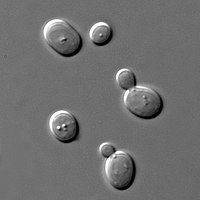
Photo from wikipedia
Eggs are used in enormous quantities throughout the world and food manufacturers produce thousands of tons of wasted chicken eggshell after processing. This poses a serious threat to the environment… Click to show full abstract
Eggs are used in enormous quantities throughout the world and food manufacturers produce thousands of tons of wasted chicken eggshell after processing. This poses a serious threat to the environment by causing waste disposal issues and pollution proliferation. Hence, calcium fortified foods have been placed on the market shelf in order to render improvement in recommended calcium intake (almost 1000 mg/day) in humans on daily basis (National Institutes of Health, 2020). This purpose of fortification is served by employing calcium derived from wide range of sources, such as calcium phosphate, calcium carbonate, calcium from dairy products and cattle bone powder (Ray et al., 2017). Cereal flour is currently the most frequently used vehicle for calcium fortification. Unfortunately, calcium in cereal is poorly bioavailable due to presence of anti-nutritional factors like phytic acid that reduce its intestinal absorption which leads to calcium deficiency (Wimalawansa et al., 2018).
Journal Title: Food Science and Technology International
Year Published: 2021
Link to full text (if available)
Share on Social Media: Sign Up to like & get
recommendations!